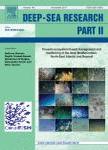版权所有:内蒙古大学图书馆 技术提供:维普资讯• 智图
内蒙古自治区呼和浩特市赛罕区大学西街235号 邮编: 010021

作者机构:CONACYT Ctr Invest Biol Noroeste Ave Inst Politecn Nacl 195 La Paz Mexico CONACYT Ctr Invest Cient & Educ Super Ensenada CI Unidad La Paz 334 Miraflores La Paz Baja California Mexico Univ Calif Santa Cruz Dept Ecol & Evolutionary Biol 115 McAllister Way Santa Cruz CA 95060 USA Ctr Invest Biol Noroeste Ave Inst Politecn Nacl 195 La Paz Mexico Univ Autonoma Baja California Sur CONACYT La Paz Mexico IPN Ctr Interdisciplinario Ciencias Marinas IPN CICIM Ave Inst Politecn Nacl S-N La Paz Mexico
出 版 物:《DEEP-SEA RESEARCH PART II-TOPICAL STUDIES IN OCEANOGRAPHY》 (深海研究,第二辑:海洋学专题研究)
年 卷 期:2019年第159卷
页 面:103-111页
核心收录:
基 金:Sistema Nacional de Investigadores (SNI) of the Consejo Nacional de Ciencia y Tecnologia (CONACYT-Mexico) National Science Foundation Graduate Student Research Program (NSF GRFP) Comision de Operacion y Fomento de Actividades Academicas del Institute Politecnico Nacional (COFAA) Programa de Estimulos al Desempeno de los Investigadores del Institute Politecnico Nacional (EDI) (IPN support programs)
主 题:Sardinops sagax Generalized additive models Climate-catch models Climate variability California current
摘 要:Small-pelagic fishes are economically and ecologically important as they make up a large proportion of wild caught fisheries and provide an important link between planktonic organisms and higher trophic level organisms such as piscivorous fishes, squid, seabirds and marine mammals. In the California Current Ecosystem (CCE), the distribution and abundance of Pacific sardine (Sardinops sagax) is influenced by both natural climate variability and exploitation. This study uses Generalized Additive Models to evaluate the effects of environmental forcing at multiple spatial scales (i.e. local, regional and basin) on sardine catch recorded at British Columbia (CAN), California (USA) and Bahia Magdalena (MEX). We find that the Pacific Circulation Index, sea surface temperature, upwelling strength, and primary productivity were the most influential factors explaining variability of sardine catch in the northeastern Pacific Ocean. Our CCE-wide analysis shows that regional scale environmental variability best explained catch rates of the Pacific sardine for California and Bahia Magdalena while basin-scale environmental variability did so for catch rates for British Columbia.